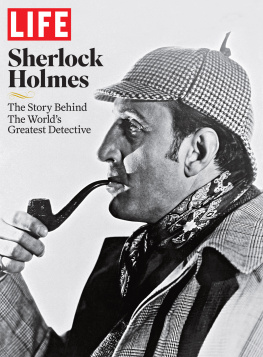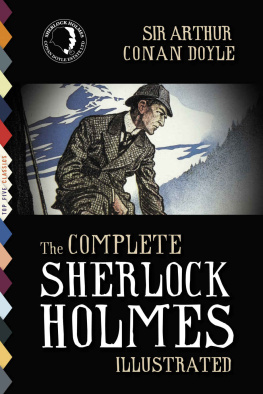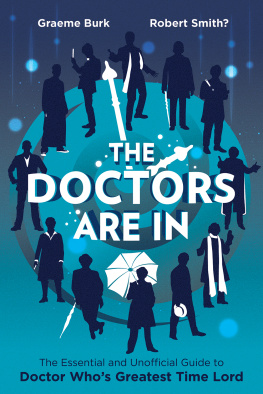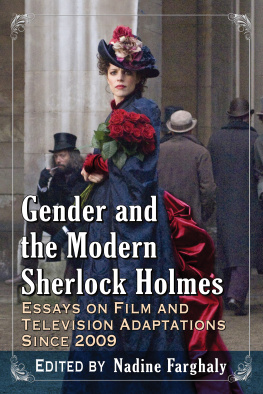SHERLOCK HOLMES
EDITED BY
TOM UE AND JONATHAN CRANFIELD
Credits
First Published in the UK in 2014 by Intellect Books, The Mill, Parnall Road, Fishponds, Bristol, BS16 3JG, UK
First Published in the USA in 2014 by Intellect Books, The University of Chicago Press, 1427 E. 60th Street, Chicago, IL 60637, USA
Copyright 2014 Intellect Ltd
Editors: Tom Ue and Jonathan Cranfield
Series Editor and Design: Gabriel Solomons
Typesetting: Gabriel Solomons
Copy Editor: Emma Rhys
All rights reserved. No part of this publication may be reproduced, stored in a retrieval system, or transmitted, in any form or by any means, electronic, mechanical, photocopying, recording, or otherwise, without written consent.
A Catalogue record for this book is available from the British Library
Fan Phenomena Series
ISSN: 2051-4468
eISSN: 2051-4476
Fan Phenomena: Sherlock Holmes
ISBN: 978-1-78320-205-8
eISBN: 978-1-78320-274-4 / 978-1-78320-273-7
Printed and bound by
Bell & Bain Limited, Glasgow
Contents
TOM UE AND JONATHAN CRANFIELD
TOM UE
RUSSELL MERRITT
Anthony Horowitz: Author of The House of Silk
LUKE BENJAMEN KUHNS
Ellie Ann Soderstrom: Author of Steampunk Holmes: Legacy of the Nautilus
JONATHAN CRANFIELD
The Team behind The Young Sherlock Holmes Adventures
NOEL BROWN
Scott Beatty: Co-author of Sherlock Holmes: Year One
JONATHAN BARNES
SHANE PEACOCK
Robert Ryan: Author of Dead Mans Land
BENJAMIN POORE
Acknowledgements
Tom Ue thanks the Canadian Centennial Scholarship Fund; the Social Science and Humanities Research Council of Canada; and University College London.
Jonathan Cranfield thanks Jacquie and Leslie. We thank Gabriel Solomans, Emma Rhys, and our contributors for their hard work, and we gratefully acknowledge permission to reprint updated versions of the following material:
Tom Ue, Sherlock Holmes and Shakespeare. 2011 Cameron Hollyer Memorial Lecture (Toronto: Toronto Reference Library, 2012).
Tom Ue, Returning to Year One: A Conversation with Scott Beatty. The Baker Street Journal: An Irregular Quarterly of Sherlockiana 62: 4 (2012), pp. 2632.
Tom Ue, Holmes Return: An Interview with Anthony Horowitz. The Baker Street Journal: An Irregular Quarterly of Sherlockiana 62: 1 (2012), pp. 2227.
Tom Ue, Holmes Steampunked: A Conversation with the Team behind The Young Sherlock Holmes Adventures. The Baker Street Journal: An Irregular Quarterly of Sherlockiana 61: 3 (2011), pp. 2331.
Shane Peacock, The Creation of The Boy Sherlock Holmes. The Baker Street Journal: An Irregular Quarterly of Sherlockiana 58: 4 (2008), pp. 1721.
Introduction
Tom Ue and Jonathan Cranfield
 do what you like with him.
do what you like with him.(Arthur Conan Doyle)
When Arthur Conan Doyle gave the actor and playwright William Gillette free reign to interpret and to revise the character of Sherlock Holmes in any way that he saw fit, he spoke truer, perhaps, than he could have known. This collection attests to the popularity of the characters and fictional world that Conan Doyle created. Theodor Adornos theorization of the culture industry could have been written with Sherlock Holmes in mind: the more the system of merchandizing culture is expanded, the more it tends also to assimilate the serious art of the past by adapting this art to the systems own requirements. Yet, as Linda Hutcheon argues, an adaptations adherence to the original should not be used as a barometer for measuring the works worth: we can appreciate an adaptation more fully by reading it as a repetition but without replication and, more specifically here, as a means for new generations of artists to engage in conversation with their literary predecessor. Hutcheon suggests that our appreciation for adaptations stems from the new aspects they bring to a text:
[An adaptation] is not a copy in any mode of reproduction, mechanical or otherwise. It is repetition but without replication, bringing together the comfort of ritual and recognition with the delight of surprise and novelty. As adaptation, it involves both memory and change, persistence and variation. (original emphasis).
The first decades of the twenty-first century have seen numerous incarnations of Holmes. Readers of this book will discover more about the Guy Ritchie films, distributed by Warner Brothers, the BBCs television production of Sherlock (Mark Gatiss and Steven Moffat, 2010), the audio drama versions of Sherlock Holmes stories by Big Finish, alongside novels by Anthony Horowitz, Governor Generals Literary Award (Childrens Text)-finalist Shane Peacock and Robert Ryan. Their work explicitly references the 1950s radio productions by NBC which featured the likes of John Gielgud, Ralph Richardson and Orson Welles. The fictional fertility of the stories have inspired the work of graphic novelists Scott Beatty and Daniel Indro and the team behind The Young Sherlock Holmes Adventures (2010), Huw-J Davies, Owen Jollands and Jane Straw, two projects that provide backstories to the sleuth. While all of these projects retain some of the features with which we identify with Holmes, what is striking here is their sheer range: Ellie Ann Soderstrom discusses the publication of the iPad app Steampunk Holmes: Legacy of the Nautilus (Noble Beast, 2013). Tom Ues chapter explores Conan Doyle and Holmes as fans of Shakespeare, and how they turn to his stories and characters in their projects. Russell Merritt tells the story of Holmess migration from motion picture theatres to television; Luke Benjamen Kuhns provides a basic vocabulary for our thinking about Holmesian pastiches; Jonathan Cranfield examines fan letters directed to Holmes; and and Noel Brown finds Sherlock Holmes in the 22nd Century (Sandy Ross, STV, 19992001) both an updating of the stories into the far future and an ideological transformation of Conan Doyles stories into didactic, educational lessons for school-age children. Jonathan Barnes and Shane Peacock offer critical reflections, respectively, on the teaching of Holmes and his recreation of the detective for Big Finish, and the creation of a past for the detective. Finally, Benjamin Poore looks at more contemporary adaptations of Holmes, particularly the BBCs Sherlock, as projects that channel manifestations of post-9/11 conspiracy-anxiety.














 do what you like with him.
do what you like with him.